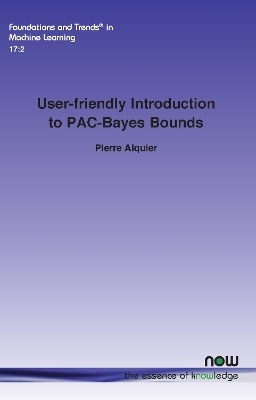
User-friendly Introduction to PAC-Bayes Bounds
Seiten
2024
now publishers Inc (Verlag)
978-1-63828-326-3 (ISBN)
now publishers Inc (Verlag)
978-1-63828-326-3 (ISBN)
Probably almost correct (PAC) bounds have been an intensive field of research over the last two decades. In this tutorial, the author guides the reader through the topic’s complexity and large body of publications. Covering both empirical and oracle PAC-bounds, this book is a primer for those who want to get to grips quickly with the subject.
Probably almost correct (PAC) bounds have been an intensive field of research over the last two decades. Hundreds of papers have been published and much progress has been made resulting in PAC-Bayes bounds becoming an important technique in machine learning.The proliferation of research has made the field for a newcomer somewhat daunting. In this tutorial, the author guides the reader through the topic’s complexity and large body of publications. Covering both empirical and oracle PAC-bounds, this book serves as a primer for students and researchers who want to get to grips quickly with the subject. It provides a friendly introduction that illuminates the basic theory and points to the most important publications to gain deeper understanding of any particular aspect.
Probably almost correct (PAC) bounds have been an intensive field of research over the last two decades. Hundreds of papers have been published and much progress has been made resulting in PAC-Bayes bounds becoming an important technique in machine learning.The proliferation of research has made the field for a newcomer somewhat daunting. In this tutorial, the author guides the reader through the topic’s complexity and large body of publications. Covering both empirical and oracle PAC-bounds, this book serves as a primer for students and researchers who want to get to grips quickly with the subject. It provides a friendly introduction that illuminates the basic theory and points to the most important publications to gain deeper understanding of any particular aspect.
1. Introduction
2. First Step in the PAC-Bayes World
3. Tight and Non-vacuous PAC-Bayes Bounds
4. PAC-Bayes Oracle Inequalities and Fast Rates
5. Beyond “Bounded Loss” and “i.i.d. Observations”
6. Related Approaches in Statistics and Machine Learning Theory
7. Conclusion
Acknowledgements
References
| Erscheinungsdatum | 30.01.2024 |
|---|---|
| Reihe/Serie | Foundations and Trends® in Machine Learning |
| Verlagsort | Hanover |
| Sprache | englisch |
| Maße | 156 x 234 mm |
| Gewicht | 213 g |
| Themenwelt | Informatik ► Theorie / Studium ► Künstliche Intelligenz / Robotik |
| ISBN-10 | 1-63828-326-5 / 1638283265 |
| ISBN-13 | 978-1-63828-326-3 / 9781638283263 |
| Zustand | Neuware |
| Haben Sie eine Frage zum Produkt? |
Mehr entdecken
aus dem Bereich
aus dem Bereich
Buch | Softcover (2024)
REDLINE (Verlag)
20,00 €
Eine kurze Geschichte der Informationsnetzwerke von der Steinzeit bis …
Buch | Hardcover (2024)
Penguin (Verlag)
28,00 €


